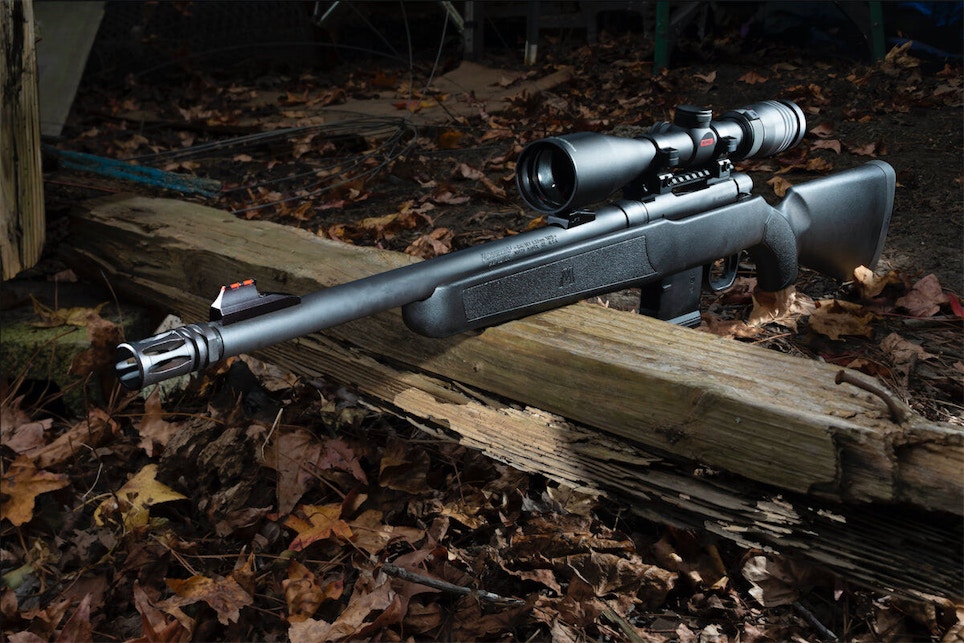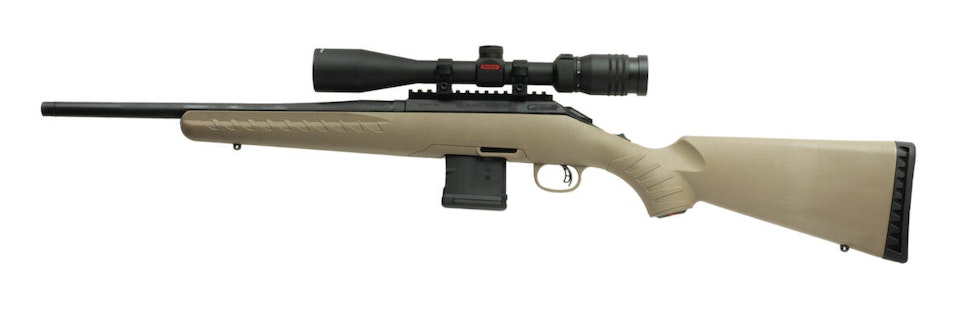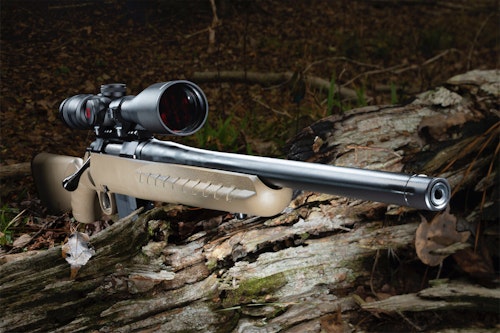Ruger and Mossberg, two of the best manufacturers in the firearm industry, deliver reliability in everything they make and stand behind their products with enviable customer service. But how well do their entry-level, bare-bones models stack up?
I ordered a couple for testing and found the features they pack into their budget offerings a refreshing change in an age of high-priced precision rifles. MSRP on both guns is less than $660.
Remaining true to a budget-conscious theme, I selected the 5.56 NATO chambering. There’s plenty of bulk-packaged practice/plinking ammunition on the market, making it one of the least expensive centerfires to shoot. The fact that manufacturers made 5.56 NATO a high priority during the height of the ammunition shortage should give customers peace of mind that ammo will be available. Plus there’s no shortage of different loads available for the cartridge — all selling points.
Ruger American Ranch Rifle
Ruger’s first American Rifles hit dealer shelves in 2012. These bolt actions were a huge success and models continue to sell extremely well. There’s good reason for the popularity. Enthusiasts get Ruger quality in a businesslike, no-nonsense gun that carries all the performance they’ve come to expect from the company.
American Rifle models are available in both long- and short-action chamberings. They wear synthetic stocks that have the company’s innovative and patented Power Bedding system. Throughout the line, except for Hunter models, each has twin stainless-steel blocks that locate the receiver and allow the cold-hammer-forged barrel to free float. The setup maximizes shot-to-shot consistency, regardless of environmental conditions. The Ruger Marksman adjustable trigger allows owners to fine tune let-off weight to their personal preference. It can be set to anywhere between 3 and 5 pounds with ease.
Other features include a three-lug bolt with 70-degree throw for faster cycling and added scope clearance. The latter, by the way, is fast to mount, thanks to the factory installed Picatinny rail atop the receiver. The American Ranch model chambered in 5.56 NATO has a nimble 16.12-inch threaded barrel with 1:8-inch rifling. Overall length of the gun is 36 inches, and it tips the scales at 6.1 pounds. The tang-mounted safety is easy to reach as is the magazine-release button on the bottom right of the stock. The 10-round GEN3 PMAG shipped with the gun and inserted effortless and dropped with ease. The stock wears a pair of sling swivels in the traditional locations and the rubbery recoil pad does a great job.
Mossberg MVP Patrol Rifle
Mossberg debuted the MVP Patrol Rifle lineup in 2013, a year after Ruger’s American Ranch launch. There are similarities other than just the 5.56 NATO chambering and they have nearly identical MSRPs.
The Mossberg also has a user-adjustable trigger. The firm’s famed LBA version comes on the rifle and operates very smoothly at settings anywhere from 3 to 7 pounds. The tested version, in 5.56 NATO, also ships with a 10-round GEN3 PMAG, although its release is just in front of the mag well. It, like the Ruger, ran flawlessly at the firing line.
The stock is also synthetic, although it wears a black finish instead of flat dark earth. The cushiony recoil pad is a generous one for the chambering, sling studs are pre-attached, and it also has a receiver-mounted Picatinny rail begging for an optic. It is, however, one groove shorter than that on the Ruger.
Significant differences are there, though. The MVP Patrol’s barrel is threaded and it comes wearing an A2-style flash hider. It’s also longer by a hardly noticeable .13 inch, but there’s no ignoring its beefier medium-bull profile when comparing it to the Ruger. The Mossberg also ships with iron sights. Up front is a red fiber-optic sight that’s nicely visible in low light and the U-notch at the rear is windage and elevation adjustable with the turn of a screw.
An oversized and textured bolt handle on the Mossberg ensures a solid grip in nasty conditions. The bolt itself is a spiral-fluted two-lug version, the stock is pillar bedded and the safety is located on the right side of the receiver, not tang mounted.
Critical Differences
Cosmetics are 100% personal preference, but if the rifles were side by side on a retailer’s shelf odds are good, you’d ask to see the Ruger first. The Mossberg stock has texturing that proved itself on the firing line, but it blends into the gun’s flat-black finish — almost vanishing at a distance. The stock isn’t completely smooth by any means, but if sweaty palms and gloves are routine during your hunts it’s a consideration.
The Ruger Ranch has a lip and grooves on each side of the fore-end to provide better grip in the wet and cold that arrive with the opening of many hunting seasons. And there’s also more generous texturing at the wrist. A Ruger logo below adds to the cosmetics. The Ruger fore-end is more rounded, ergonomic, so to speak. Mossberg’s is flatter at the bottom, lending itself to better stability from sandbags or a flat rest. Your shooting style and preference determines which you prefer, so we’ll chalk this one up to a tie.
Advantage Mossberg when it comes to the iron sights, though. They are quickly vanishing on most of today’s guns, but on this style of rifle a wise addition — an adjustable one, too. The company’s choice in barrel profile and going with a flash hider instead of a flat protector are also nice touches.
Spiral fluting is popular on today’s bolts, but it blends in, almost disappears in Mossberg’s dark finish. When you’re out in the blind, though, looks don’t make much of a difference. The bigger, gripped bolt handle on the MVP Patrol does, however, give it the advantage. Both bolts ran smoothly without any problems at the firing line, with cartridges feeding and extracting without fail — even from standard-capacity, 30-round AR-15 magazines. Reduced bolt throw on the Ruger gives it an advantage in scope clearance and theoretical follow-up shot speed, but there were no problems in testing with the mounted Redfield 4-12x40mm scope with either gun. I don’t hold the qualifications to join the high-speed club, so I didn’t detect a difference even when turning bolts furiously. Ruger’s advantage, however, is a mathematical reality.
Mossberg’s safety is in a position most veteran bolt-rifle owners will consider intuitive, although Ruger’s is right next door. Regardless which model you go with it won’t take much time to hit that mag release with efficiency. Both are clever locations, letting you release and grab the magazine in a single motion. On the Ruger, depress the button with the thumb while grasping the magazine. Use your index finger on the bar in front of the magazine on the Mossberg. Nice.
At the Firing Line
The objective lens was too big to clear the adjustable rear sights when mounting the Redfield on the Mossberg. To maintain consistency in testing, I removed the U-notch assembly on the iron sight. It took only a few seconds but, considering the 40mm front lens is relatively modest by today’s standards, some eye-relief experimenting, or higher-profile bases might be in order for owners who want an optic.
Ammunition used in testing included American Eagle 50-grain JHP, PMC 55-grain FMJ BT and Federal Premium 69-grain Match King. All were .223 Rem. cartridges, which likely affected accuracy findings slightly.
The Ruger showed a distinct preference for the Federal load, averaging 1.54-inch groups at 100 yards from a sandbagged prone position. Things widened significantly from there, with the other cartridges coming in at more than 2 inches. Mossberg’s Patrol, on the other hand, produced its best groups with the lighter American Eagle load. It averaged 2.11-inch groups. There’s no doubt quality 5.56 NATO ammo would make things more consistent.
Which Rifle’s Best?
Precision isn’t the mission of either rifle. In more capable hands, however, after break-in and taking the time to find a pet load, there’s no doubt both rifles would print significantly smaller groups. Will they shrink to MOA? Perhaps, but there’s no denying the fact both guns remain true to their mission. The goal isn’t about tiny groups as much as it is surviving years of abuse and neglect and still connecting at moderate distance without hiccup or undue maintenance. Inexpensive ammo is a bonus.
Your customers can’t go wrong with either one if they’re looking for a truck gun or budget platform that will survive brutal conditions. Which one’s better depends on their shooting style, not pocketbook depth.









